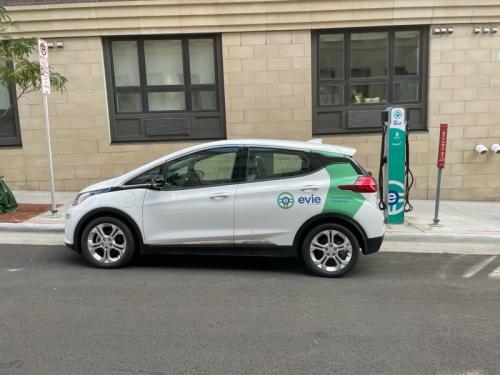4 ways U.S. cities are accelerating the switch to EVs

Photo courtesy of Shutterstock/Paul Craft.
As gas prices surge past $5 a gallon and the global climate crisis deepens, city leaders stand on the front lines of America’s transition to more sustainable and affordable transportation options.
Cities are taking bold steps to accelerate the changeover to electric vehicles (EVs), using their purchasing power to prime new markets for electrified cars, trucks, buses, and bikes, and making it easier for residents to make the switch. Leading the way are 25 cities who received support and resources from Bloomberg Philanthropies' network of partners while participating in the American Cities Climate Challenge.
Mayors in these cities increasingly see transforming transportation as critical to delivering results for residents when it comes to sustainability, equity, and public health. The transportation sector is the single largest source of carbon emissions in the United States. It’s also a driver of air pollution and respiratory conditions such as asthma that disproportionately impact people of color and low-income households. On both fronts, electric vehicles offer benefits over models that run on fossil fuels.
"We can’t afford to wait for someone else to take the kind of bold action on climate change we need to protect our community,” Albuquerque, N.M., Mayor Tim Keller said while announcing his city’s first purchase of EVs for the municipal fleet. “Any realistic effort to fight climate change has to include steps to reduce the impact of vehicles on our air quality and public health…and the time has come to turn the page on gas-powered cars and trucks.”
With billions of federal infrastructure dollars available to supercharge this transition, local leaders will have an even bigger role to play in the years ahead. Cities that want help navigating federal infrastructure funding opportunities can sign up for supports through the Local Infrastructure Hub, a new initiative of Bloomberg Philanthropies and its partners.
Here are four ways that the 25 cities that participated in the American Cities Climate Challenge are driving innovation with electric vehicles—using data, resident engagement, and collaboration to make a lasting impact.
1. Establishing community car sharing programs and charging stations
Car-sharing programs have already shown that they can save participating households thousands of dollars and take cars off the street. Now, cities are electrifying these car-sharing programs, expanding access to both EVs and places to charge them, particularly for traditionally underserved communities.
St. Paul, Minn., for example, launched the largest publicly owned, renewably powered, electric car-sharing program in the nation, Evie Carshare, with 100 EVs currently operating and plans to grow the fleet to 173. Equitable access was a major factor in determining the pricing structure and charging locations. The program design was informed by a prototyping process with residents and, to make it affordable to all, Evie Carshare includes a discounted membership rate for people with low incomes. Car-share locations also include spots where anyone with an EV can charge up, effectively boosting the number of public EV charging ports in the city by 70 percent.
Similarly, Boston partnered with E4TheFuture and the Massachusetts Clean Energy Center for the launch of the EV car sharing program Good2Go. It’s an income-tiered service with a focus on equity that enables qualifying residents to pay as little as $5 per hour to use a vehicle. Meanwhile, St. Louis is piloting a program for social services agencies to share EVs in order to shuttle seniors to medical appointments and to deliver meals. The agencies are seeing savings in reduced fuel costs, freeing up resources for other services.
2. Electrifying municipal fleets
City leaders also are looking at their own fleets of vehicles as a big opportunity to reduce carbon emissions, cut fuel and maintenance expenses, and lead by example. Across the American Cities Climate Challenge, 22 cities have already purchased more than 1,300 electric vehicles and have made plans to purchase dramatically more in the years ahead.
St. Louis, for example, started by adding four new EVs to its municipal fleet, and plans to acquire at least eight more in the coming months. Each vehicle is labeled “Zero Emissions 100% Electric” with eye-catching green streaks on the side, to promote the change with residents. For the long term, an executive order requires city agencies to continue prioritizing the purchase of low- and no-emission vehicles to keep the municipal fleet transition going.
Albuquerque has likewise committed to a 100-percent clean light-duty fleet, meaning that any eligible pickup truck and passenger vehicle purchased from now on will be an electric, hybrid, or alternative-fuel vehicle. Meanwhile, Boston added a new kind of vehicle to its municipal fleet: an electric-assist cargo tricycle. City leaders are testing it to see if employees would be willing to use the e-bike for work-related trips instead of a car or truck.
3. Electrifying public transit
City buses are a ripe target for electrification. Compared with existing diesel models, electric buses significantly reduce air pollution, make less noise, lower maintenance and operating expenses, and can deliver a more comfortable experience for passengers.
Honolulu is looking to leverage all of those benefits as part of an effort to make public transit a more attractive option for residents. In addition to building its first dedicated bus lane since 1988, the city has incorporated 17 fully electric buses into its service routes. It’s also installed a charging system to support the process of transitioning 100 percent of the city’s bus fleet to fully electric by 2035. These zero-emission electric buses are not only providing cleaner transportation, but they are notably quieter, to the enjoyment of passengers and residents.
In Charlotte, N.C., the city council approved a groundbreaking approach to overcome initial hesitation about upfront costs of transitioning to electric buses. A pilot program enables the city to try out—and train staff on—18 electric buses and charging infrastructure from various manufacturers in order to collect data on what works. The program is an important first step in the city’s mission to reach net-zero emissions targets and has the potential to be a model for other cities.
4. Requiring new buildings to be ready for EV charging infrastructure
For EV owners, more than 80 percent of their vehicle charging occurs at home. But workplaces are also a popular place to charge. That’s why a number of cities are requiring newly constructed residential and commercial buildings to design-in the ability to scale up future EV charging infrastructure. Doing so up front adds less than 0.2 percent to construction costs, while sparing much higher costs associated with retrofitting buildings later.
Through its new EV Ready code, Orlando, Fla., is now requiring all new buildings and major remodel projects to integrate EV charging infrastructure. Specifically, the ordinance requires 20 percent of multi-family, hotel, and parking structure spaces and 10 percent of non-residential parking spaces to be EV-capable, which requires installing dedicated electrical capacity and conduit to parking spaces. By starting with community engagement workshops and then collaborating with developers and EV-industry stakeholders, city leaders garnered support needed to pass this ordinance, a major milestone in achieving its sustainability goal of reducing greenhouse-gas emissions 90 percent by 2040. Similar EV-readiness ordinances recently passed in Boston, Columbus, Ohio, Charlotte, St. Louis, and Pittsburgh.
Explore resources created for local governments to accelerate EV adoption in their own communities here:
A Policy Toolkit for EV deployment and adoption at the local level
Electric Transportation Toolkit to help support electrification plans and community engagement
A report from Forth Mobility about centering equity in charging investments to accelerate vehicle electrification
Electric Vehicles For All: An Equity Toolkit from Greenling provides tools and resources to ensure low-income consumers gain access to EVs


